|
Since
the introduction of Hornadyís little seventeen caliber
rimfire cartridge almost two years ago, I have fired hundreds of
them through several different guns. I am still surprised at
times by the accuracy of the little cartridge. Out of a
twenty-two inch rifle barrel, the .17 HMR leaves the muzzle at
over 2500 feet per second. The trajectory of the seventeen
is also much flatter than that of any other rimfire cartridge. I
have tried the .17 HMR in several rifles and one revolver, not
counting the Ruger Single-Six, which is the subject of
this article.
Rugerís
new .17 HMR is built on their New Model Single-Six frame, which
has been in production for thirty years now, and incorporates
Rugerís transfer bar safety mechanism, allowing the safe
carry of a fully loaded cylinder. The Single-Six revolvers are
very popular, and the .17 HMR cartridge is well suited to the
little sixgun.
The
Single-Six .17 HMR has a six shot cylinder, adjustable sights,
rosewood grip panels, and is made of blued steel and black
anodized aluminum. The only barrel length available at this time
is six and one-half inches. The American Rifleman
magazine had a review of this gun in their September 2003
edition, and this would be a good time to clear up a couple of
errors reported in their article. They erroneously reported that
the sixgun has a six inch barrel and walnut grips, and this has
caused a bit of confusion. It is obvious from their own photos
that the gun has rosewood grips and a six and one-half inch
barrel, just as does the sample that I have here for testing.
The
.17 Single-Six has a nice blue-black finish, and the aluminum
grip frame and ejector rod housing match the finish of the steel
parts very well. The rosewood grip panels are fitted very well
to the grip frame, much better than some Rugers that I have seen
in the past few months, and are inlaid with the Ruger silver
eagle medallions. The sights are square and black, just as
they should be, and the rear is adjustable for windage and
elevation. The sides of the hammer and trigger are polished and
left in the white. The trigger pull on the seventeen measured
five and one-half pounds, but after a quick poor
boyís trigger job, now breaks cleanly at three pounds
and one ounce. The barrel has six grooves with a twist of
one turn in nine inches. While the Single-Six has a
smaller frame, the grip frame is the same size and shape as
Rugerís larger Blackhawk, and the little sixgun balances well,
weighing just under 36 ounces. The cylinder length measures
1.406 inches; just right for the .17 HMR cartridge. The barrel
to cylinder gap measures a consistent two one-thousandths
of an inch (.002"), and there is no perceptible end to end
play of the cylinder. The little sixgun is very well fitted. The
Single-Six comes supplied with a hard plastic storage case,
cable lock, and instruction manual.
For
accuracy and functioning testing, I had a supply of Hornady 17
grain Varmint Express ammunition along with some CCI 17
grain TNT hollow point ammo. Range conditions had calm winds and
an air temperature of seventy-eight degrees. From the Rugerís
six and one-half inch barrel, the CCI ammo averaged a
speed of 1944 feet per second, and the Hornady clocked in at
1993 fps, all at a distance of ten feet from the muzzle. Initial
accuracy testing was at a distance of twenty-five yards using a
rested position. Accuracy of the little Ruger with the open
sights was good, with five-shot groups measuring just over one
and one-half inches. However, the groups showed almost no
vertical stringing, but the largest spreads were on the
horizontal plane, which to me indicated shooter error. In other
words, I wasnít holding the gun consistently from shot to
shot. While one and one-half inch groups ainít bad, I
suspected that the gun could do better, so I decided to see if a
scope sight could help me to hold the gun more consistently.
An
inquiry to Weigand Combat Guns quickly resulted in the
arrival of one of their excellent no-gunsmithing scope bases,
along with a set of their scope rings. The Weigand scope base
only requires the removal of the rear sight, and does not
permanently alter the gun. The whole scope mounting operation
took only about five minutes, solidly mounting an old Charles
Daly two power scope atop the little Ruger.
I
expected the group sizes to shrink with the scope, but I was
definitely surprised at how tight the groups were. As can be
seen in the photos, this Single-Six really can shoot! That is a
dime used for comparison in the photos. The Hornady ammo grouped
five shots into just five-sixteenths of an inch at
twenty-five yards, and the CCI grouped five into just
three-eighths of an inch. Moving the target out to one hundred
yards resulted in five shot groups measuring just under one and
one-half inches, with a slight wind on that day. I must
confess that I never would have thought that the Single-Six
would be this accurate. For a six shot revolver, especially in
the Rugerís price range, that is amazing accuracy! Even after
the little seventeen got dirty, there were no failures to
function of any kind. Ejection was smooth and easy, with most
empties falling out of the cylinder without the aid of the
ejector rod.
The
Ruger .17 HMR Single-Six balances well and points naturally in
my hand, which has become very familiar to the feel of a single
action over the years. The Ruger would make a dandy little
sixgun for pest and small varmint control out to about 125 yards
with the issue sights, or a bit further with a scope mounted in
the Weigand Combat base and rings. The .17 extends the practical
range for rimfire handgun plinking, shooting faster and flatter
than the .22 magnum. Out of a revolver, the seventeen beats the
velocity of the .22 magnum by about 500 feet per second., and
flattens the trajectory considerably.
Once
again, I have been impressed by the accuracy of the .17 Hornady
Magnum Rimfire, and equally impressed by the performance of this
Single-Six.
Check out the full line of Ruger products
here.
For
more information on, or to order one of the Weigand Combat
mounts, go to: www.jackweigand.com.
If you have a handgun that
needs a scope mount, chances are that they have one to fit.
Jeff Quinn
  
Got something to say about this article? Want to agree (or
disagree) with it? Click the following link to go to the GUNBlast Feedback Page.
|
|
Click pictures for a larger version.
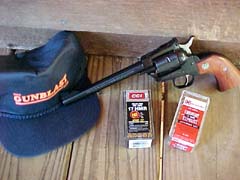
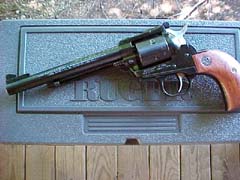
The excellent .17 HMR cartridge has found a new home in
Ruger's Single-Six revolver.
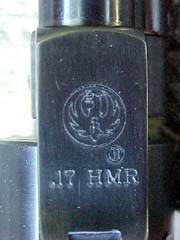
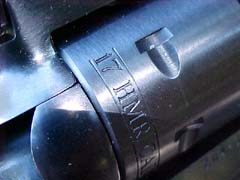
The proven design of Ruger's Single-Six is a natural fit
for the little .17 HMR.
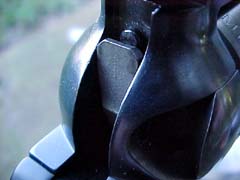
The Single-Six .17, like all their New Model sixguns,
features Ruger's transfer bar safety system. This allows the
Single-Six, unlike older Single Action revolver designs, to
safely carry a fully loaded cylinder.
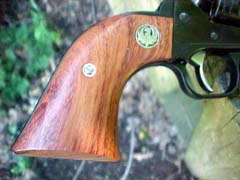
The Single-Six .17 features a well-fitted set of
rosewood grip panels.

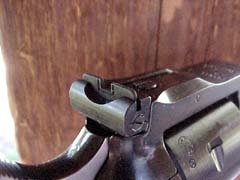
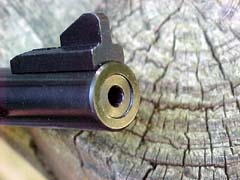
To aid in accurate shooting, the Single-Six .17 features
a ramp front sight, fully-adjustable rear sight, and a
recessed muzzle crown.

Both CCI and Hornady factory ammo have proven to be very
accurate in other .17 HMR guns the author has tested, and Jeff
looked forward to seeing what the .17 HMR would do in a Ruger
Single-Six.
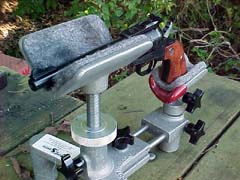
The Single-Six .17 was fired for accuracy from Jeff's Target
Shooting, Inc. gun rest, and showed good accuracy with
iron sights, but Jeff believed that iron sighs really didn't
do the gun / cartridge combination justice.
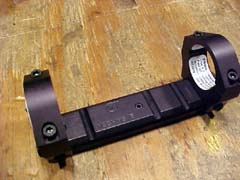
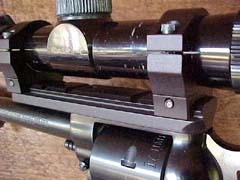
To really see what the Single-Six .17 would do, Jeff
mounted a scope in one of Weigand Combat Guns' excellent
"no-gunsmithing" scope mounts.

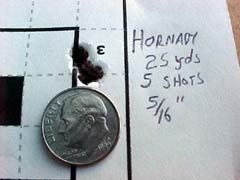
Author was honestly surprised by the consistent level of
accuracy shown by the scoped Single-Six .17 . That little
Ruger sixgun shoots like a rifle!
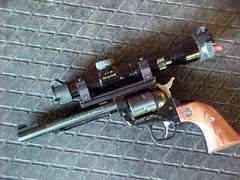
Long a fan of Ruger sixguns, Jeff learned that our
friends in Southport, CT still have a few aces up their
sleeves! For short-range varminting or just plain fun, the
Ruger Single-Six .17 can't be beat.
|
![]()